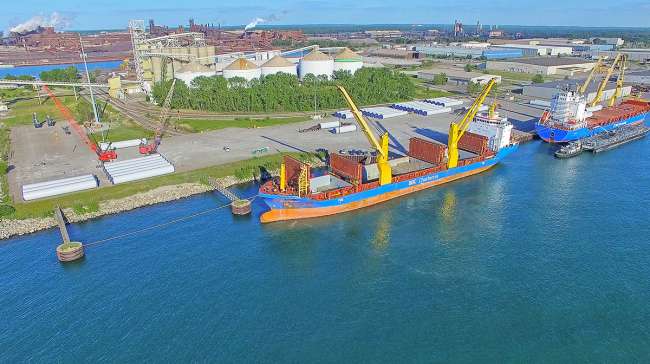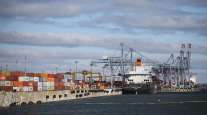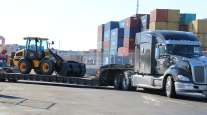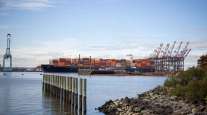Staff Reporter
CBP OKs Ports of Indiana Plan for Ocean Container Terminal

[Stay on top of transportation news: Get TTNews in your inbox.]
Creation of Lake Michigan’s first international container terminal serving the Chicago area is underway since U.S. Customs and Border Protection officials approved a Ports of Indiana-Burns Harbor plan to open a new all-water ocean vessel supply chain route.
“At this point, we have just received formal approval from U.S. Customs to begin planning an international container terminal, and several things need to happen before we can start shipping containers through Ports of Indiana-Burns Harbor,” Ports of Indiana CEO Jody Peacock said. “First, we will work with Customs to design the appropriate security and inspection facilities, and then we will have to obtain appropriate funding to purchase equipment and construct facilities both for the Customs inspections and for container terminal operations.”
Peacock said port officials next will work to secure customers and partners to support establishing regular container service between the Greater Chicago metropolitan area and various international ports. The goal will be to complete all planning, financing, construction and procurement efforts by next year so initial shipments can start in 2026.
“Indiana is a hotbed for manufacturing and agriculture, so we are seeing strong interest in exporting containers of high-protein soybeans, premium corn, specialty hardwoods and manufactured goods. Inbound shippers have expressed interest in moving food products, refrigerated containers, pharmaceuticals and high-tech products,” Peacock noted. “When you’re dealing with a diverse market like the Greater Chicago area, there are opportunities for a wide range of consumer goods, but it will be difficult to predict which industries will be interested in diversifying their supply chain on a new route.”

Peacock
The Burns Harbor terminal is located in northwest Indiana within the Greater Chicago metro area. While the Chicago metro area is home to the largest intermodal container market in North America, all containers moving through the Chicago market travel by rail or truck.
Peacock said that although the Port of Indiana's three facilities have a unique commodity mix and multimodal supply chains, they rely heavily on the trucking industry to keep commerce moving.
“Introducing an all-water route from Europe to the Chicago-northwest Indiana market can replace longhaul truck routes with shorter shuttle route opportunities. A local terminal can allow truckers to carry multiple loads on local routes and be home at night as opposed to spending multiple days driving cross-country with one container at a time,” he explained. “Having an all-water container route into the Midwest could create transformational opportunities, but it will take time to develop. Our port has the capabilities to handle containers today, but we won’t be able to schedule regular container shipments until the Customs facilities are fully operational, potentially in 2026.”
About the Port
Established: 1961
2023: 12.6 million tons of cargo shipped, second-most in the port's history
Multimodal facilities: Three in Indiana (Ohio River: Jeffersonville and Mount Vernon; Lake Michigan: Portage-Burns Harbor area)
CBP approval was provided in a letter stating it determined the project justifies the need for a staffed CBP container cargo examination facility at the Burns Harbor port. The Ports of Indiana will be responsible for providing infrastructure construction to include a CBP office, equipment, furnishings, supplies, large-scale noninspection equipment, radiation portal monitors and security per CBP’s specifications. Construction and installation of the facility and equipment is expected to occur next year.
Ports of Indiana-Burns Harbor is located minutes from interstates 94, 80, 90 and 65, and already relies on hundreds of thousands of trucks annually to move cargoes. It handles 3.5 million tons of cargo yearly including bulk, breakbulk and project cargo.
Turning an #EconomicGrowth vision into reality: @CBP approved our request to build the #Chicago region's first international sea cargo container freight terminal at a#BurnsHarbor, a better-for-the-environment, lower-cost gateway to world markets! Details: https://t.co/M0aNnpMdK9 pic.twitter.com/hIlTnCTp9P — Ports of Indiana (@PortsofIndiana) July 2, 2024
About half of the port’s annual tonnage is steel-related cargoes since it is located in the heart of America’s largest steel-producing region. Other major types of cargo are fertilizer, grain, minerals, salt, fuels, coke and limestone.
“Developing new container facilities at our ports can support local economic growth and provide a positive transformation in supply chains that combine multimodal transportation more efficiently, leveraging the benefits of trucking for the critical first- and last-mile connections,” Peacock noted. “Introducing containerized cargo offers the opportunity for all port service providers and trucks to handle higher-value cargoes that will need premium service.”
Port officials have established memorandums of understanding from potential partners and obtained letters of support from other Great Lakes ports and more than 35 government officials, businesses and trade associations.

McCoy
“Among U.S. Great Lakes ports, Cleveland and Duluth currently handle container vessels, while Monroe, Mich., is also pursuing CBP approval. Adding Burns Harbor to the list of Great Lakes container ports would allow shippers to utilize a network of container terminals which now includes the largest metropolitan area on the Lakes,” according to a Ports of Indiana statement.
Ryan McCoy, port director at Ports of Indiana-Burns Harbor, said, “Great Lakes shipping is limited by a shorter shipping season and the use of smaller vessels, but the potential upside for handling containers is tremendous. Allowing ocean carriers to start serving this market could diversify supply chains, avoid bottlenecks and reduce the overall carbon footprint for shipping to and from the Midwest.”
Want more news? Listen to today's daily briefing below or go here for more info:




